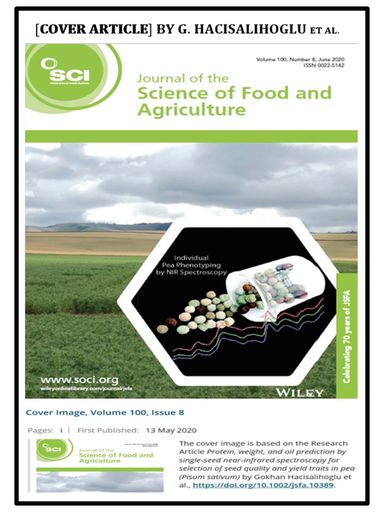
DR. GOKHAN HACISALIHOGLU
TITLE: PROFESSOR OF BIO SCI, FLORIDA A&M UNIVERSITY
EDUCATION:
Ph.D.-Cornell University, Ithaca, New York
Postdoctoral Research: Cornell & USDA-ARS
LEADERSHIP POSITIONS:
- STEM Leadership Fellow [CASL], Washington, DC
- ACUE-Certificate in Effective College Instruction
- FAMU Teaching Innovation Award Winner
- Cold Spring Harbor Laboratory-[Build.Leadership]
TEACHING / COURSES:
- BOT3303 Plant Morphology
- BOT2313 Plant Anat. & Development
- ISC1058 Scientist Life Skills
- BSC4931 Biol-Professional Sem.
- BIO308 Plant Physiology
- BSC1010 General Biology I
DR. G. HACISALIHOGLU-RESEARCH LAB FOCUS:
- Project 1: Single-Seed Based Phenomics: My research has opened the door to developing new research methods and tools such as near-infrared (NIR) spectroscopy and X-ray micro-CT to potentially quantify seed composition and quality traits. Specific seed composition traits I seek to predict are oil, protein, starch, minerals, volume, and density.
- Project 2: Ionomics & Plant Nutrition: My team and I are studying genetic variation by screening hundreds of plant genotypes for zinc, phosphorus, and nitrogen traits. Our Zn efficient genotypes increase productivity and quality of plant species such as bean, wheat, and soybean in low zinc soils. We are also mapping QTLs for mineral composition, to be used for marker-assisted breeding with their differential expression contribution to low P tolerance in plants. This project provides critical sustainable solutions for both growers and industry.
-
CONTACT: Email: gokhan.h@famu.edu
Dr. G. Hacisalihoglu |Prof.BiolSci.| Florida A&M University| Tall., Florida
(PI): USDA1890Research ||STEM.Leader.Fellow| Fulbrightsp.
#Research Solutions in: Seeds’.Potential +Plant.Nutrition (from A.to.Zinc) +STEMedu
#goOER-downloadhere: https://diginole.lib.fsu.edu/islandora/object/fsu%3A761479
>>FOLLOW: https://twitter.com/oeronstemcenter
°°°°°°°°°°°°°°°°°°°°°°°°°°°°°°°°°°°°°°°°°°°°°°°°°°°°°°°°°°°°°
Recent Publications
visit Google Scholar page:https://scholar.google.com/citations?user=VJARXSAAAAAJ
[47]Hacisalihoglu G & Armstrong PR (2022) Flax and Sorghum: Multi-Element Contents and Nutritional Values within 210 Varieties Pot Selection for Future Climates to Sustain Food Security. Plants 11(3):451. https://doi.org/10.3390/plants11030451 [FEATURE PAPER].
[46]Hacisalihoglu G (2022) Unraveling the Mechanisms of Zinc Efficiency in Crop Plants: From Lab to Field Applications. Plants. 11(2): 177.
[45]Hacisalihoglu G etal. (2021) Characterization of pea seed nutritional value within a diverse population of Pisum sativum. PLoS ONE 16(11): e0259565. https://doi.org/10.1371/journal.pone.0259565
[44]Hacisalihoglu G (2021) From Growing to Biology: Plants 1e. Publisher: Florida State University. 157 pages. ISBN13: 9781736577912 https://diginole.lib.fsu.edu/islandora/object/fsu%3A761479
[43]Hacisalihoglu G (2020) Zinc (Zn): The Last Nutrient in the Alphabet and Shedding Light on Zn Efficiency for Future of Crop Production under Suboptimal Zn. Plants. 9(11): 1471; https://doi.org/10.3390/plants9111471
[42]Hacisalihoglu G, Stephens D, Stephens S, Johnson L, Edington M (2020) Enhancing Undergraduate Student Success in STEM Fields through Growth-Mindset and Grit. Educ. Sci. 10: 279; https://doi.org/10.3390/educsci10100279
[40]Hacisalihoglu G etal. (2020) Protein, weight, and oil prediction by single‐seed near‐infrared spectroscopy for selection of seed quality and yield traits in pea (P. sativum). Journal of the Science of Food and Agriculture 100(8): 3488-3497. https://doi.org/10.1002/jsfa.10389 [COVER ARTICLE].
[38]Hacisalihoglu G & Strickland C (2019) Fields of Gold: Plant Prospecting for Precious Metals. National Center for Case Study Teaching in Science (NCCSTS), 1-15. http://sciencecases.lib.buffalo.edu/cs/collection/detail.asp?case_id=1075&id=1075 [37]Hacisalihoglu G etal. (2018c) Modulation of early maize seedling performance via priming under sub-optimal temperatures. PLOSONE 13(11): e0206861. https://doi.org/10.1371/journal.pone.0206861
[36]Hacisalihoglu G, Stephens D, Johnson L, Edington M (2018b) The use of active learning approach in a SCALE-UP learning space improves academic performance in UG Gen Biology. PLOSONE 13(5): e0197916. https://doi.org/10.1371/journal.pone.0197916
[35]Hacisalihoglu G etal. (2018a) Quantitative trait loci associated with soybean seed weight and composition under different phosphorus levels. Journal of Integrative Plant Biology 60(3): 232-241. https://doi.org/10.1111/jipb.12612
[34]Hacisalihoglu G & Settles AM (2017) Quantification of Seed Ionome Variation in 90 Diverse Soybean (Glycine max) Lines. Journal of Plant Nutrition 40(20):2808-2817. https://doi.org/10.1080/01904167.2017.1382528
[31]Hacisalihoglu G etal. (2016) Enhanced Single Seed Trait Predictions in Soybean & Robust Calib. Model Transfer. J Agric Food Chem 64:1079-86. https://doi.org/10.1021/acs.jafc.5b05508
[29]Hacisalihoglu G & Settles AM (2013) Natural Variation of Seed Composition of 91 Common Bean Genotypes and Their Possible Assoc w Seed Coat Color. Journal of Pl Nutrition 36(5):772-80. https://doi.org/10.1080/01904167.2012.754041
[27]Hacisalihoglu G etal. (2010) Near infrared reflectance spectroscopy predicts protein, starch, and seed weight in intact seeds of common bean. Journal of Agricultural and Food Chemistry 58(2):702-706. https://doi.org/10.1021/jf9019294
Last Updated: March’22 (Dr. G. Hacisalihoglu)




